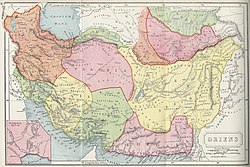Ariana
Ariana
Ἀρ(ε)ιανή | |
|---|---|
District | |
 The Atlas of Ancient and Classical Geography by Samuel Butler and Ernest Rhys, showing Ariana in the east (yellow) based on Eratosthenes descriptions. | |
| Country | Modern day Afghanistan, parts of Modern day Iran, and western Pakistan |
| Empire | Achaemenid |
Ariana was a general
At various times, various parts of the region were governed by the
Etymology
The Greek term Arianē (Latin: Ariana), a term found in Iranian Avestan Airiiana- (especially in Airyanem Vaejah, the name of the Iranian peoples' mother country).[2] The modern name Iran represents a different form of the ancient name Ariana, which was derived from Airyanem Vaejah and implies that Iran is the Ariana itself, a word that is found in Old Persian,[7] a view supported by the traditions of the country preserved in the Muslim writers in the 9th and the 10th centuries.[8]
The Greeks also referred to Haroyum/Haraiva (Herat) as Aria, which is one of the many provinces found in Ariana.[9][10][11]
The names Ariana and Aria and many other ancient titles, of which Aria is a component element, are connected with the Avestan term Airya-, and the Old Persian term Ariya-, a self-designation of the peoples of Ancient Iran[12] and Ancient India, meaning 'noble', 'excellent' and 'honourable'.[1]
Extent
The exact limits of Ariana are laid down with little accuracy in classical sources. It seems to have been often confused (as in
As a geographical term, Ariana was introduced by the Greek geographer, Eratosthenes (c. 276 BC – c. 195 BC) and was fully described by the Greek geographer Strabo (64/63 BC – ca. AD 24).[13]
Per Eratosthenes' definition, the borders of Ariana were defined by the
By Herodotus Ariana is not mentioned, nor is it included in the geographical description of Stephanus of Byzantium and Ptolemy, or in the narrative of Arrian.[1]
Inhabitants of Ariana
The peoples by whom Ariana was inhabited, as enumerated by Strabo were:[18]
- Arachoti;
- Arii;
- Bactrians;
- Drangae;
- Gedrosii;
- Paropamisadae;
- Parthians;
- Persians
- Sogdians.
- Angutturi;
- Arii;
- the inhabitants of Daritis;
- Dorisci;
- Drangae;
- Evergetae;
- Gedrussi;
- Ichthyophagi;
- Methorici;
- Pasires;
- Urbi;
- Zarangae.
Rüdiger Schmitt, the German scholar of Iranian Studies, also believes that Ariana should have included other Iranian peoples. He writes in the Encyclopædia Iranica:
Eratosthenes’ use of this term (followed by
Zarathushtra is said to have preached Ahura Mazdā's laws "among the Arianoi").[2]— R. Schmitt, 1986
See also
References
- ^ a b c d e Smith, William (1980). "Ariana". Dictionary of Greek and Roman Geography. Boston: Little, Brown, and Co. pp. 210–211. Retrieved 2013-05-10.
- ^ a b c Schmitt, R. (1986). "Aria". Encyclopaedia Iranica. Retrieved 2013-05-10.
- ^ Lewis, Charlton T.; Short, Charles. "Ărĭāna". A Latin Dictionary. Perseus Digital Library. Retrieved 2013-05-10.
- ^ The Columbia Encyclopedia, Sixth Edition, 2008
- ISBN 9788172110284.
According to Strabo (c. 54 B.C., A.D. 24), who refers to the authority of Apollodorus of Artemia, the Greeks of Bactria became masters of Ariana, a vague term roughly indicating the eastern districts of the Persian empire, and of India.
- Naturalis Historia, book vi, page 23
- ^ Gnoli, G. (2006). "Iranian identity ii. Pre-Islamic Period". Encyclopaedia Iranica. Retrieved 2013-05-10.
- ^ Ashraf, A. (2006). "Iranian identity iii. Medieval Islamic Period". Encyclopaedia Iranica. Retrieved 2013-05-10.
- ^ Ed Eduljee. "Haroyu, Aria / Airan, Herat & Zoroastrianism". Heritageinstitute.com. Retrieved 2016-10-21.
- ^ Ed Eduljee. "Aryan Homeland, Airyana Vaeja, Location. Aryans and Zoroastrianism". Heritageinstitute.com. Retrieved 2016-10-21.
- ^ Ed Eduljee. "Aryan Homeland, Airyana Vaeja, in the Avesta. Aryan lands and Zoroastrianism". Heritageinstitute.com. Retrieved 2016-10-21.
- ^ Schmitt, R. (1987). "Aryans". Encyclopaedia Iranica. Retrieved 2013-05-10.
- ^ Strabo 2.1.22f
- ^ Strabo 2.5.32
- ^ Strabo 11.11.1
- ^ "LacusCurtius • Strabo's Geography — Book XV Chapter 2".
- ^ Gnoli, Gherardo (2002). The "Aryan" Language. Roma: Instituto Italiano per l'Africa e l'Oriente. p. 86.
- ^ "Strabo Geography, Book XV, Chapter 2". Penelope.uchicago.edu. Retrieved 2013-05-10.
Further reading
- Horace Hayman Wilson, Charles Masson, Ariana Antiqua: a Descriptive Account of the Antiquities and Coins of Afghanistan, 1841
- Henry Walter Bellew, An inquiry into the ethnography of Afghanistan, 1891
- Tomaschek in Pauly-Wissowa, II/1, cols. 619f., and 813f.
- G. Gnoli, Postilla ad Ariyō šayana, RSO 41, 1966, pp. 329–34.
- P. Calmeyer, AMI 15, 1982, pp. 135ff.
External links
- The Online Etymology Dictionary: Aryana
- 'Ărĭāna', Charlton T. Lewis, Charles Short, A Latin Dictionary, Perseus Digital Library.
- 'Ariana', Dictionary of Greek and Roman geography, William Smith, 1870
- 'Stabo GeographyY', Book XV, Chapter 2.
- Pliny the Elder, The Natural History, Chap. 23. (20.)—The Indus, Perseus Digital Library.
- Pliny the Elder, The Natural History, Chap. 25.—The Ariani and the adjoining nations, Perseus Digital Library.
- Pomponius Mela: De Chorographia Liber Primus
- Ariana antiqua: a descriptive account of the antiquities and coins of Afghanistan By Horace Hayman Wilson, Charles Masson
- Eratosthenes, Duane W. Roller, Strabo, 2010, 'Eratosthenes' Geography'
